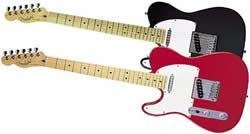 Electric Guitar. Made by Fender.
Electric Guitar. Made by Fender.No other guitar can match it -- the Fender Stratocaster is where the great guitar tradition began and still carries on today!
Featuring a fast-action maple neck, comfort-contoured body, three single-coil pickups and standard synchronized tremolo, the Fender Standard Strat is the guitarist's guitar! Pick one up and you hold the whole history of rock and roll in your hands...
Features
- BODY Alder
- NECK Maple, Modern "C" Shape, (Satin Polyurethane Finish)
- MACHINE HEADS Fender/Ping Standard Cast/Sealed Tuning Machines
- FINGERBOARD Maple, 9.5" Radius (241 mm)
- NO. OF FRETS 21 Medium Jumbo Vintage Style Frets
- PICKUPS 3 Standard Single-Coil Strat Pickups (Ceramic Magnets)
- CONTROLS Master Volume, Tone 1. (Neck Pickup), Tone 2. (Middle Pickup)
- BRIDGE Vintage Style Synchronized Tremolo
- PICKUP SWITCHING 5-Position Blade: Position 1. Bridge Pickup, Position 2. Bridge and Middle Pickup, Position 3. Middle Pickup, Position 4. Middle and Neck Pickup, Position 5. Neck Pickup
- HARDWARE Chrome
- STRINGS Fender Super Bullet 3250L, Nickel Plated Steel, (.009 to .042)
- PICKGUARD 3-Ply White
- SCALE LENGTH 25.5" (648 mm)
- WIDTH AT NUT 1.650" (42 mm)
- UNIQUE FEATURES Vintage Styling
- ACCESSORIES Includes Fender Gig Bag
NOTE: The picture on this page shows a gutiar with a Rosewood neck, if you order from this page you will receive this same model guitar with a Maple neck
For novice guitar players, learning to play chords can seem daunting. Watching skilled guitarists, it seems effortless, but actually doing it yourself may prove a bit more challenging. However, as with anything, regular practice and an understanding of the basics can make guitar chords more accessible than you think. While playing one-string melodies can be a fun way to get accustomed to guitar playing, the true personality and flavor of guitar music relies on chords.
What is a guitar chord? Simply put, a chord is performed by striking two or more strings on a guitar. More specifically, this generally involves playing some combination of fretted and open strings. For instance, the A5 chord is played by holding down the second fret of the D string, and striking both the A and D string together. The A major, on the hand, requires the second frets of the D, G, and B strings to be held down, and all strings except the low E string to be played.
One of the big challenges in playing guitar chords is the need to use several fingers in a relatively cramped space, while putting even pressure on each fret, all while ensuring you only strike the strings you're supposed to. It can be challenging at first, but it does get easier with practice. Some more complex chords require multiple strings to be fretted by the same finger (barre chords), requiring even more finger flexibility. Perhaps the most challenging aspect of chords is the need to quickly and smoothly transition from one chord to the next. Again, experienced players make this look like a cinch, but it does take some getting used to.
To help learn how to finger certain chords, there are many easy-to-follow tools available to the novice player. Guitar chord diagrams may be the easiest to understand when practicing chords. These are basic diagrams that show the basic layout of a guitar neck (vertically), and notate which frets to press and which strings to strike. Guitar tablature (tabs) work in a similar fashion, and show you how to finger the chord while actually playing a song. Here, the neck is shown horizontally as it would appear if the guitar were laying face up on your lap, and numbers on each string indicate which fret should be held. For example, a "1" on the G string would indicated that the 1st fret should be pressed, while a "0" would mean the string should be played open. No number means the string is not played at all.
While learning guitar chords does take some work, it is well worth the effort. Chords give new depth and richness to guitar music that can't be achieved by playing single strings. Look online for resources for learning how to play different chords, such as chord diagrams and guitar tabs. With perserverance, it won't be long until chords come naturally and require almost no effort or extra thought.
TeachYourselfHowToPlayGuitar is an online portal with expert articles about essential guitar tips and guides. To learn more about how to effectively learn to play the guitar, visit http://www.teachyourselfhowtoplayguitar.com for free access.
fender 50th anniversary stratocaster